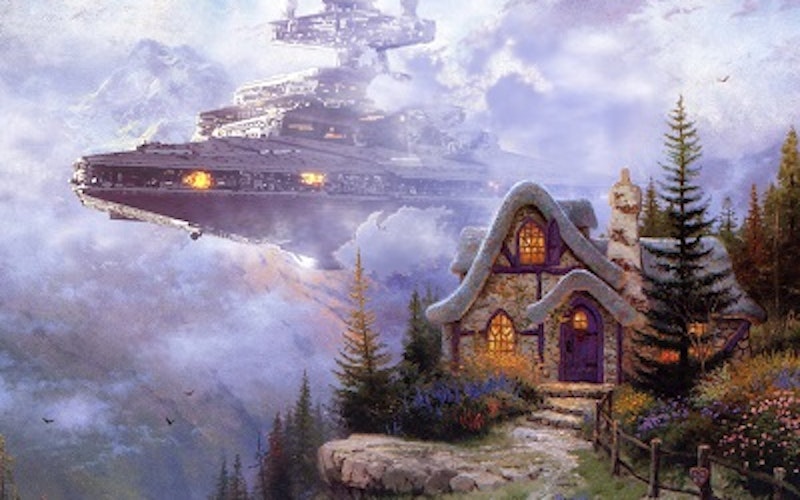
Music
How Star Wars helped me appreciate Thomas Kinkade
Andy Rau •
The last light of day fades slowly behind the horizon, leaving the forest bathed in gentle moonlight. Smoke curls from the chimney of a cozy stone cottage. And on the far side of a babbling brook, a pair of Imperial AT-AT walkers plods into view. Yes, Star Wars has invaded the paintings of Thomas Kinkade.
You’ve probably seen Jeff Bennett’s remarkable Stars Wars/Kinkade mash-ups, in which he digitally adds Star Wars creatures and vehicles into pastoral Kinkade paintings. They call to mind Chris McMahon and Thryza Segal’s memorable addition of monsters into thrift-store landscape paintings. In Bennett’s mash-ups, the uncanny-valley weirdness of Kinkade’s artificial settings is set against the overt fantasy of Star Wars, creating a Warholesque salute to and mockery of American kitsch.
Beyond the black humor of showing Stormtroopers torching those too-cheerful cottages, these mash-ups are effective because they point out that Kinkade’s idealized vistas, packed to the gills with carefully manufactured coziness, nostalgia and innocence, aren’t any less fantastic than George Lucas’ alien-filled galaxy far, far away.
And maybe that’s the best way to understand the comforting (to some) and infuriating (to others) work of the late Thomas Kinkade.
Over the years, Kinkade has been hammered by critics from all sides. Art critics have skewered his work as cloying and saccharine - all sentimentality, no substance. The religious component of Kinkade’s work provided another channel for criticism. To mainstream critics, Kinkade’s many personal stumblings and questionable business operations made a mockery of his Christianity-infused art. To many religious observers, the escapist theology of Kinkade’s relentlessly cozy paintings was troublesome. Joe Carter’s 2010 analysis, which looks at Kinkade’s technical execution and theology as one problematic whole, is perhaps the most insightful critique I’ve read.
Maybe if I approach Kinkade’s work in the way I do George Lucas’, I can make peace with it.
I’ve agreed with many of these criticisms, so it’s funny that it’s taken a digitally superimposed rancor to make me reconsider, and maybe even appreciate, Kinkade’s oeuvre. Maybe if I approach Kinkade’s work in the way I do George Lucas’, I can make peace with it.
I love Star Wars. Like a few million of my peers, I grew up with Star Wars. I’ve spent countless hours immersed in the escapist fantasy of its black-and-white moral universe and its overly simple, unrealistically happy endings. And I even enjoy Lucas’ later works, which (like Kinkade’s later paintings), jettison so much of his original films’ genius and get completely lost within themselves. I can watch the dreaded Star Wars prequels, cringing at their technical execution and lazy ethical scenarios, but still finding genuine joy in the escapist moral fables they want to be.
So why not extend the same courtesy to Kinkade’s overly simple, unrealistically happy universe?
I think we’ve overstated our criticism of the quality and theology of the Kinkade empire and might be better off thinking of it as just another entertainment franchise. Let’s judge it on that basis, without forcing it to hold its own against Pablo Picasso (as art) or Charles Spurgeon (as preaching).
Now, here’s hoping the next round of Kinkade/Star Wars mash-ups will let the Rebel Alliance get into the action.
Topics: Movies, Culture At Large, Arts & Leisure, Art